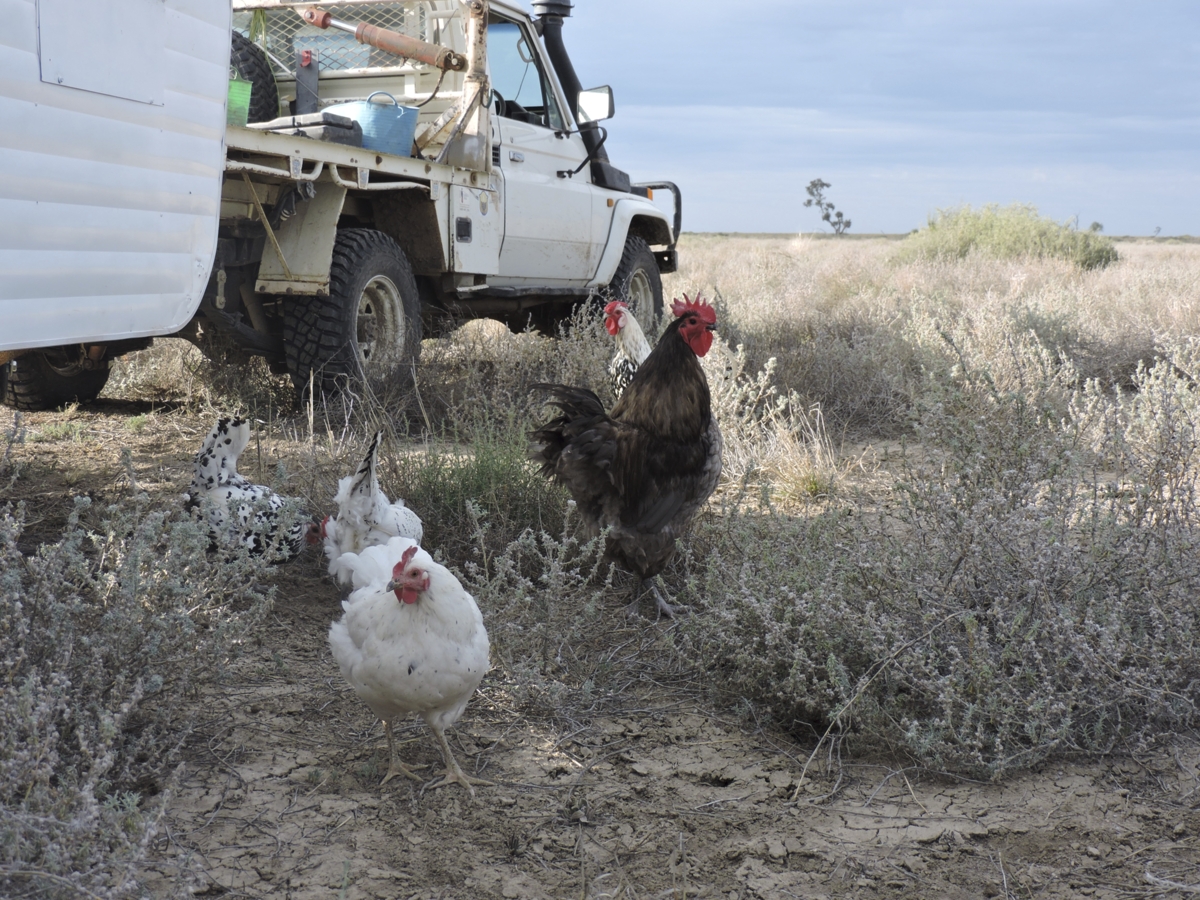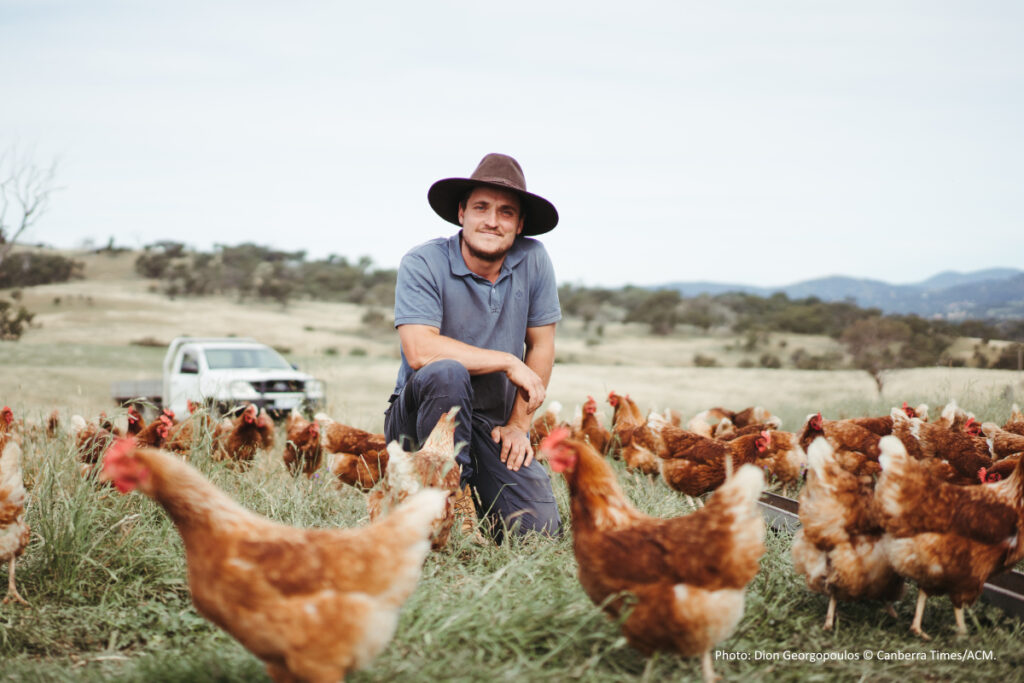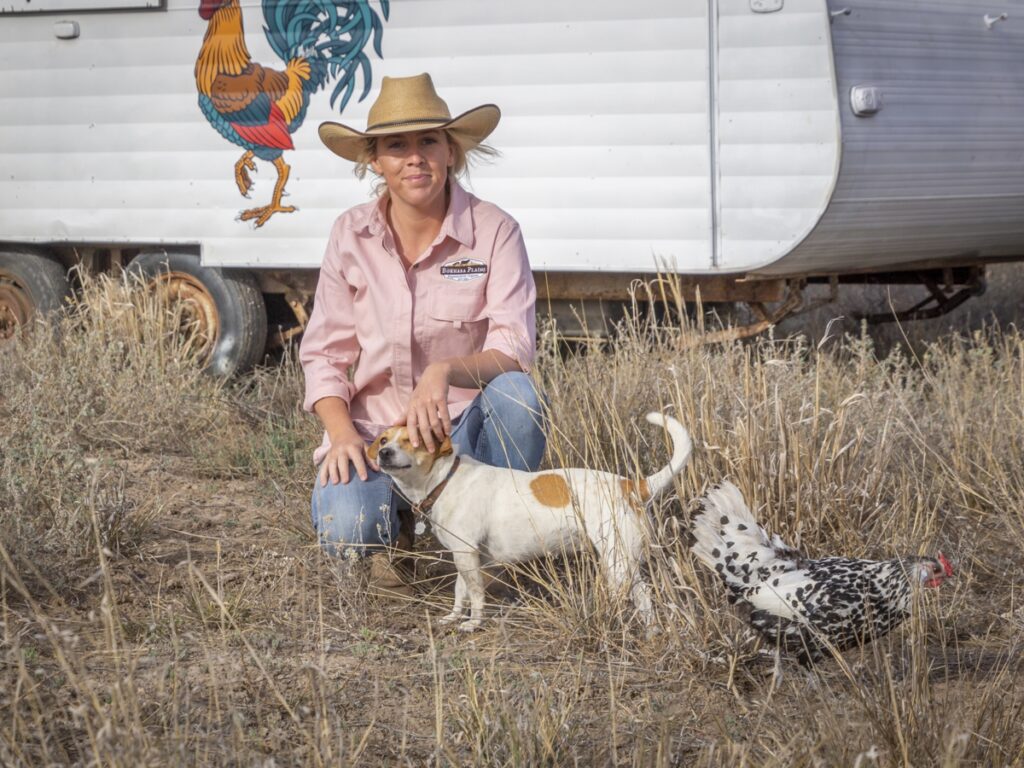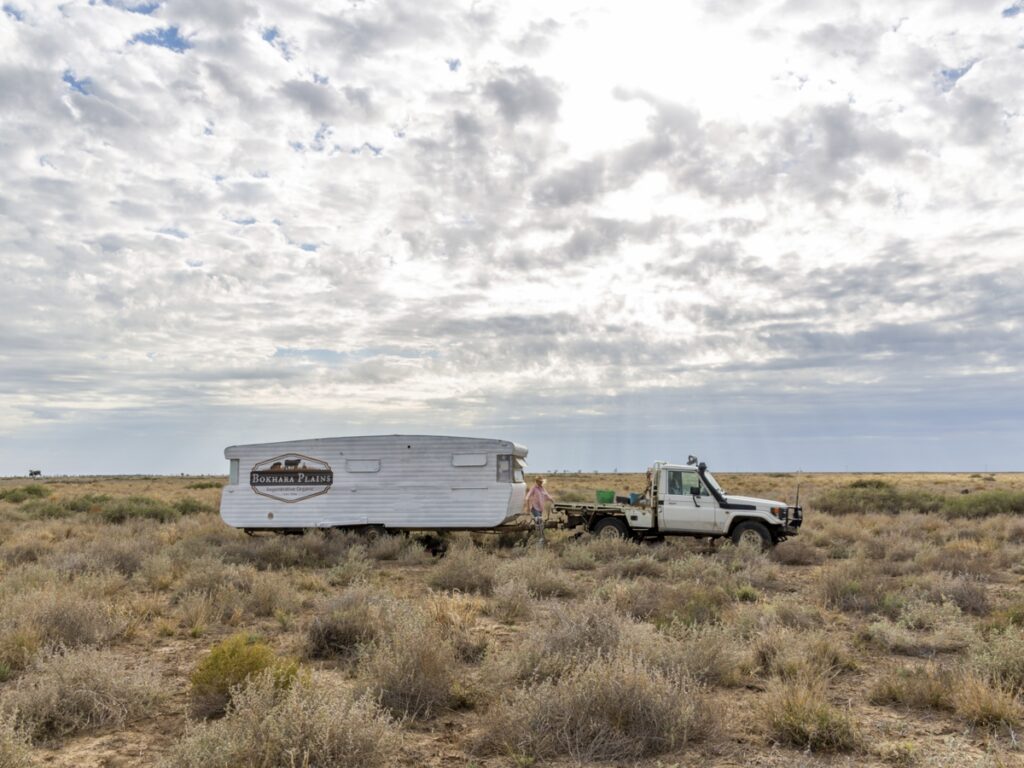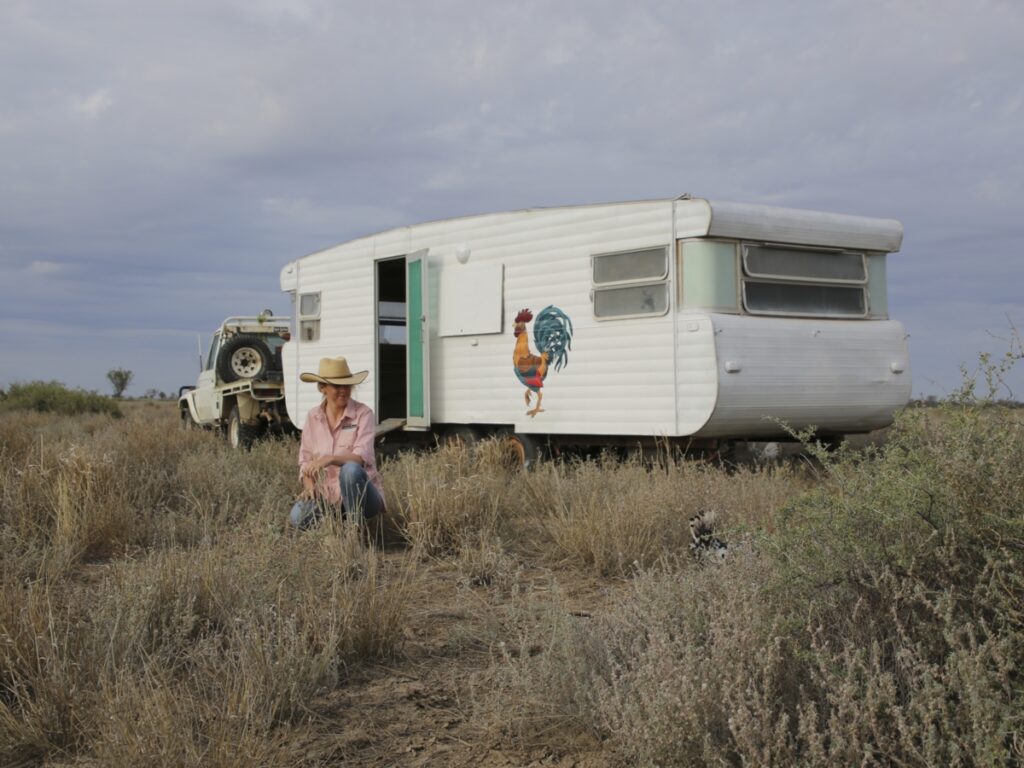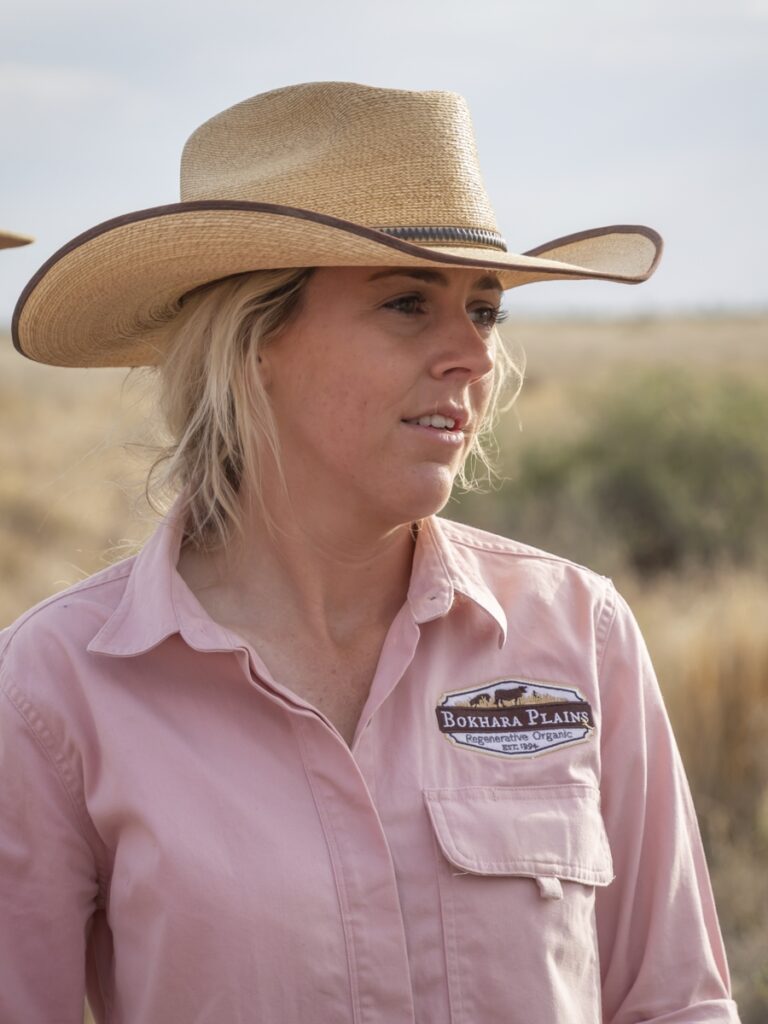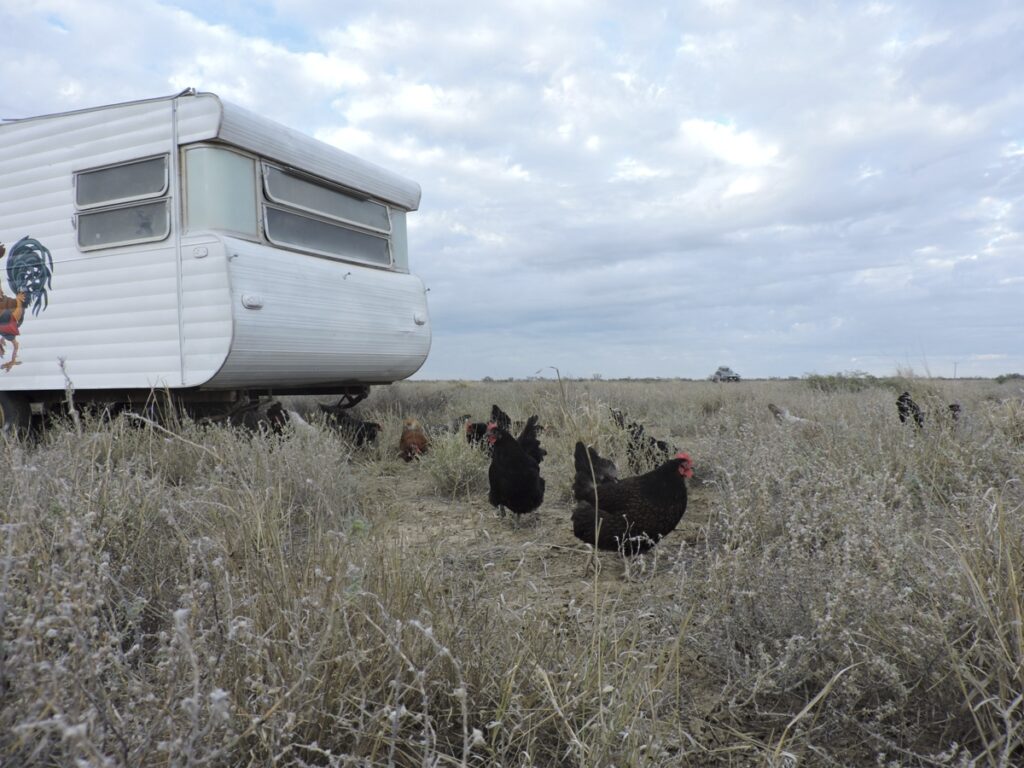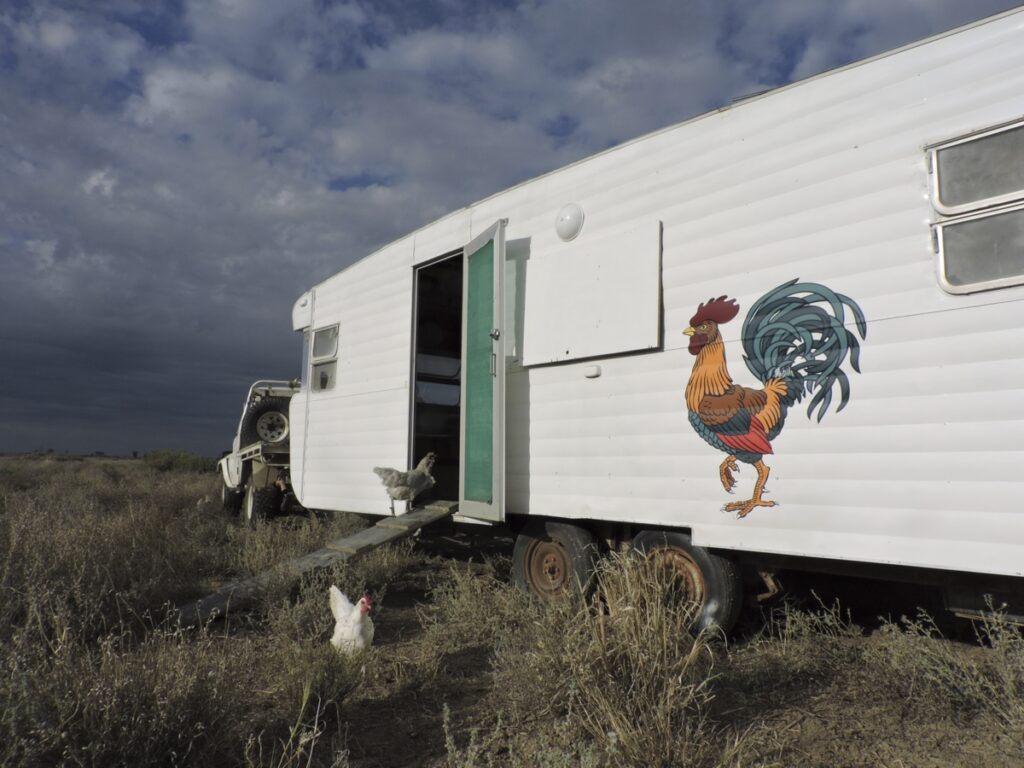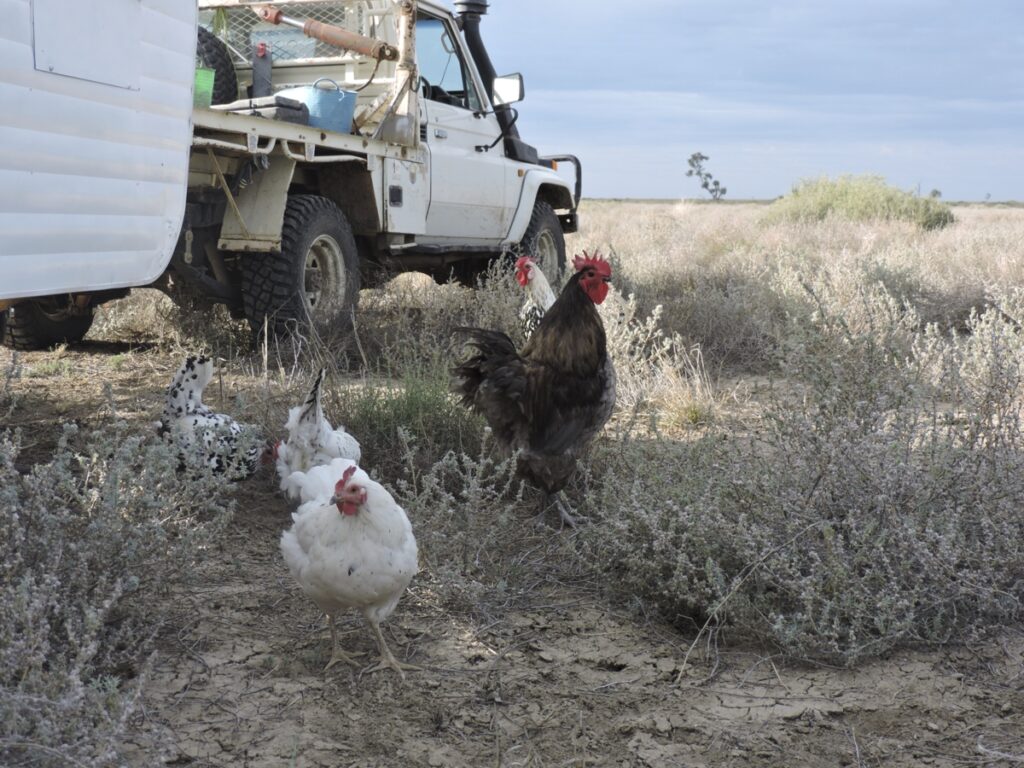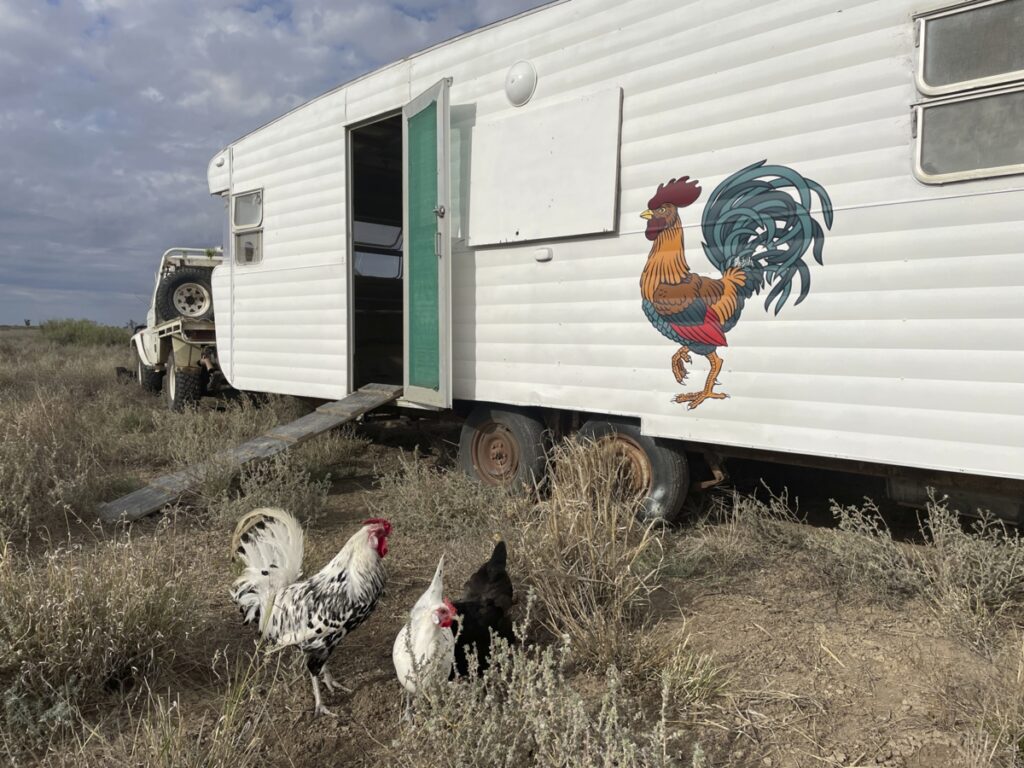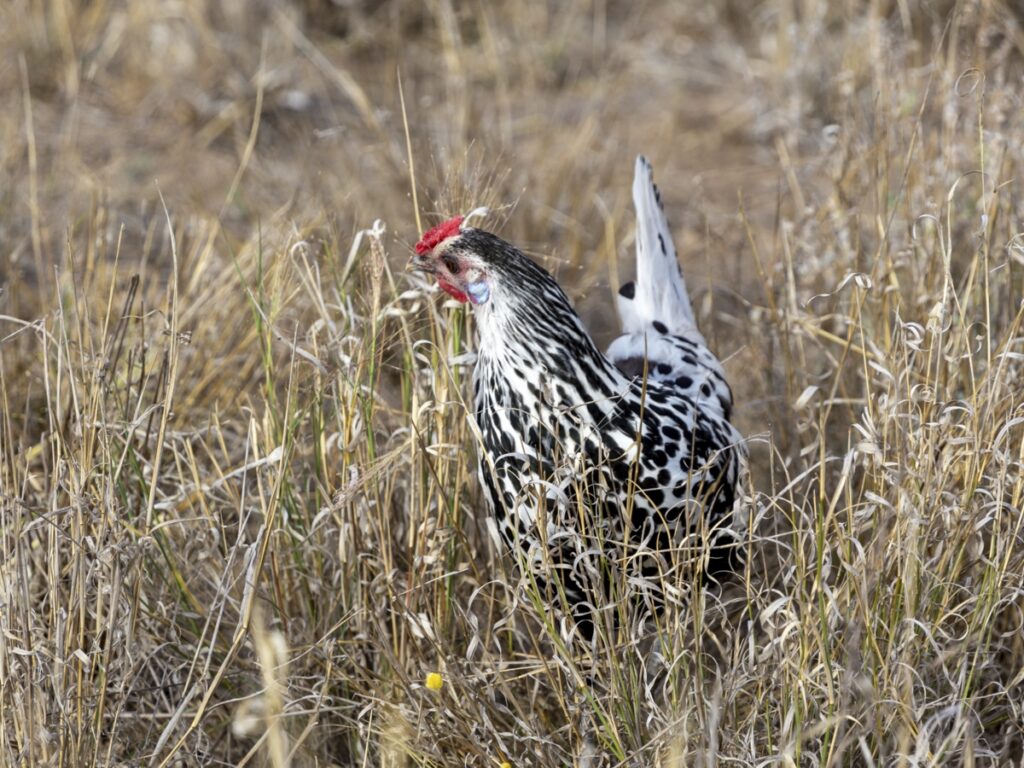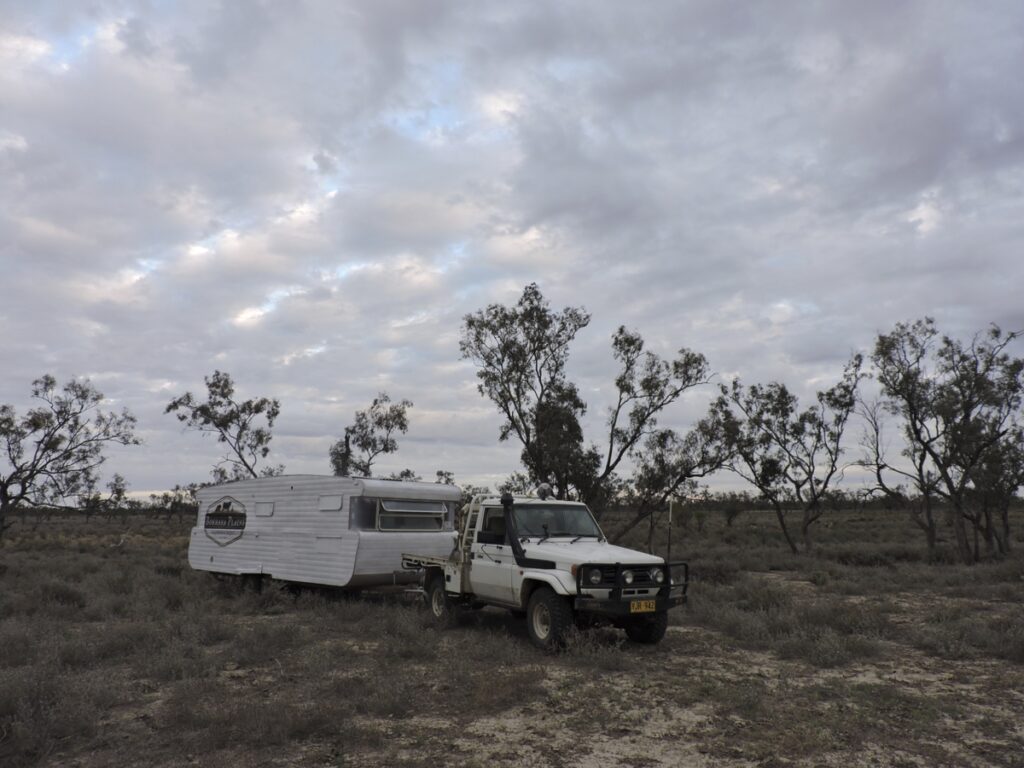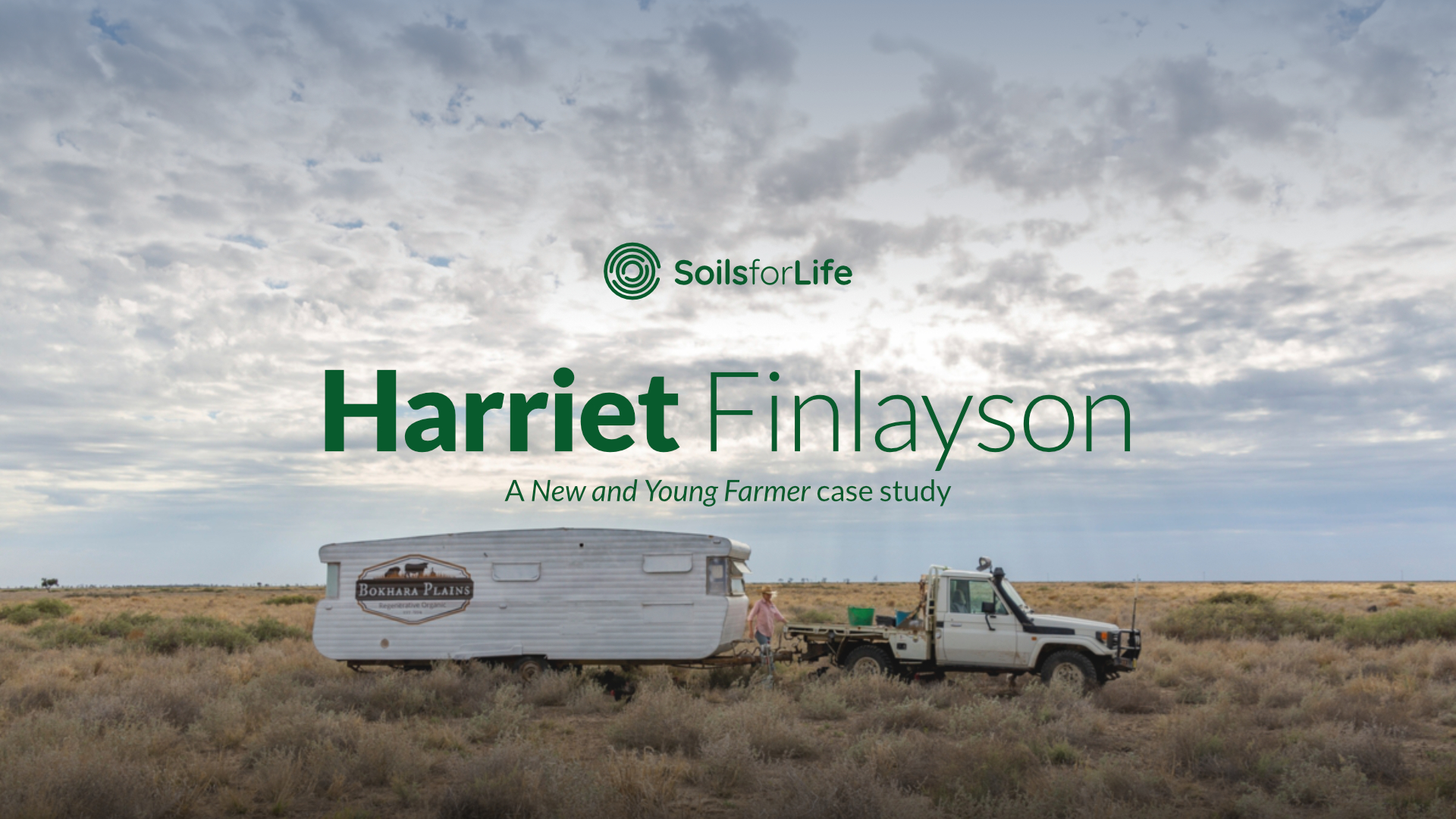"Young Farmers Raising Pasture-fed Chickens"
A YOUNG FARMER CASE STUDY
Meet Harriet Finlayson and Adam Lilleyman, two young Australian farmers. Both Harriet and Adam developed their enterprises on land owned by their parents, and are working through questions facing young farmers, such as access to capital, learning pathways and peer support.
Harriet Finlayson lives and works on the NSW rangelands property Bokhara Plains with her parents, Graham and Cathy Finlayson. A couple of years ago, Harriet returned home to support her parents’ beef enterprise, as well as develop her own poultry enterprises. Beginning in the COVID-19 lockdown, Harriet is learning about various types of poultry – chickens, ducks, turkeys – by starting small and slow. Her ultimate goal is to focus on chicken and duck meat, but while she gets started, she is selling the eggs.
Adam Lilleyman is a doctoral student at Australian National University (ANU), while also running a new pasture-raised chicken enterprise on his parents’ property – Amberly, just outside Canberra. His goal is to offer ethically raised eggs, while incorporating the chickens into a multispecies grazing regime with Amberly’s cattle, as a means to regenerate soil health. Starting with 500 hens, two Maremma guard dogs and a purpose-built mobile hen trailer, Adam is experiencing increasingly high levels of demand for his eggs. Currently, Amberly farm hosts on average between 3,000 and 4,000 Hyline hens.
Both Harriet and Adam are practicing ‘regeneratively pasture-raising chickens’, as distinct from ‘pasture-raising chickens’. A regenerative mindset means viewing the chickens for what they can bring back to the land, which then changes how the chooks are managed. For example, pasture-raised chickens might stay in the same paddocks for long periods, which would lead to nutrient overload, bare patches and unproductive soil. However, regenerative chicken enterprises are moved strategically to enhance the landscape, soil, and regeneration of native species where possible. Simply stated by Adam, ‘chickens regenerate when managed, but otherwise they don’t. A regenerative mindset allows you to get that benefit from the chickens.’
In this thematic case study, we share the stories of these two young farmers, to illustrate their practices for supporting landscape regeneration, as well as the barriers and opportunities for young farmers wanting to help improve Australia’s soil health. Firstly, we present how they do what they do and secondly, we present the impact they hope to have and are having.
Farm Facts
Location
Annual Rainfall
Agro-climatic region
Property Size
Elevation
Social Structure
Enterprise Type
Soils*
*Learn more about soil classifications at Soil Science Australia
Harriet Finlayson
Location
Ngemba, Ualarai, Murrawarri and Wailwan Country | Brewarinna, NSW
Annual rainfall
380mm
Agro-climatic region
Rangelands pastoral
Property size
9,200ha
Elevation
115m
Social structure
Daughter of owner and operators (Graham and Cathy Finalyson)
Enterprise type
Pasture-raised poultry as part of cattle enterprises. Beef cattle agistment and trading; accommodation and event venue
Soils
Self-mulching black soils to lighter clays
Adam Lilleyman
Location
Ngunnawal Country | Kambah, ACT
Annual rainfall
620mm
Agro-climatic region
Temperate cool season wet
Property size
105ha
Elevation
587m
Social structure
Son of owner and operators (John and Carol Lilleyman)
Enterprise type
Free-range eggs as part of a mixed enterprise including, 20 breeder cattle, market plants and on-site music studio
Soils
Kurosols (dominant) and Rudosols (minor occurences) (DPIE 2021)
*Learn more about soil classifications at Soil Science Australia
Videos
The Highlights
- Integrating pastured-raised chickens with existing cattle operations on parents’ property, where the chickens add nutrients to the soil, as well as help process and pasteurise the cattle dung
- Focusing on quality of produce, not quantity of produce
- Succession planning with their parents
- Creating their own learning journey
- Values based vision, for healing the land and ethical produces
- Starting slow and building up, learning-by-doing
- Repurposing what is available on the farm rather than using capital to buy new, or repurposing new equipment to meet unique needs
- Bringing their own skills to the family operations, such as building apps and social marketing
- Using transparency to build trust and commitment with customers
- Taking pride in what they do, rather than feeling a sense of obligation
- Building a sense of community support and pride in their enterprises
- Receiving positive feedback on the quality and taste of their eggs
- Harriet has increased access to local food in regional NSW and Adam’s enterprise is contributing to local employment opportunities, with five staff
- Monitoring for improvements in soil function with pasture-raised chickens
Harriet’s and Adam’s story
- Stage 1 - Getting started
- Stage 2 - Pasture-raised chooks
- Stage 3 - Managing chickens for land benefits
- Stage 4 - Conditions for long-term success
Getting started
This stage explores how Adam and Harriet began their enterprises.
Adam began his chicken enterprise in 2017, and Harriet started her enterprise during COVID-19 lockdown in 2020. When getting started, they both had to navigate challenges common to young farmers. Research[1] undertaken in 2021 into young ‘regenerative and agro-ecological famers’ in Australia articulates these common challenges as access to: land, capital, learning pathways and social support. This stage explores how Harriet and Adam navigated some of these challenges for getting started.
[1] https://www.farmerincubator.org/regenerationreport
Access to land
Accessing land is one of the biggest challenges for young Australian farmers, due to the purchase prices and the challenges of leasing (Massy, 2021). Even if young farmers come from a farming family, their access to land might not be guaranteed. Older generations often need to continue farming later into their retirement years because of the financial context of conventional farming and are not able to financially transition the land to younger generations (Massy, 2021). However, both Harriet and Adam were able to develop their enterprises on land owned by their parents.
Adam’s parents, John and Carol Lilleyman, were new to farming when they purchased their property later in life. Key to the Lilleymans’ succession planning was the inclusion of their adult children in the decision to buy and run the property. Having made the decision as a family, their children took ownership of the idea as well. John and Carol provide enough support and space to enable the children to live out their dreams too.
Harriet, on the other hand, grew up on her property. Her parents always gave her space to decide if and when she wanted to come back herself. Harriet left for university, travelled overseas, and worked in Sydney. According to Harriet, though, her parents have ‘made it very hard for me to not want to come back based on what they’ve done. My parents have always been very positive people and show that there’s so much opportunity to do all sorts of good work here. I always wanted to come back.’
Access to capital
Access to capital is another big challenge for young farmers (Massey, 2021). Harriet’s strategy for manoeuvring through the start-up costs were firstly to start small and go slow. Harriet recognises that if she bought 100 chickens at once, she could have had a lot of problems quickly. It may have been a blessing in disguise that she began by ordering fourteen fertilised chicken eggs and six fertilised duck eggs in the mail during the COVID-19 pandemic, to learn slowly.
Another principle of Harriet’s to help reduce the need for capital is to use and repurpose what is available on the farm. Harriet, along with her father and friends, have repurposed an old caravan for the chickens and are using the regenerated dams to raise the ducks. In the future, Harriet would like to make her own mulch from plants on the farm. And when it comes time to produce meat, she plans to sell all possible parts and to compost everything else back into the landscape.
The eggs enterprise, which Adam championed, was funded as part of the family farm business. While the family worked together to fund the business in its early stages, Adam started, expanded, and continues to manage the enterprise. Like Harriet, Adam started small and built up over several years as the family gained confidence in this new area of agriculture.
Access to hands on learning pathways
Another challenge for young Australian farmers concerned about soil health is the lack of hands-on learning pathways, as well as courses that move beyond the techno-centric approach (Massey, 2021). As such, many of the next generation growers are, ‘creating their own educational pathways’, citing ‘podcasts, YouTube and internships’ as their self-created learning journey (Massy, 2021).
Driven by her own curiosity, Harriet has taught herself about regenerative pasture-raised poultry farming through podcasts, books and videos, by those in regenerative agriculture and soil stewardship. For online resources of leaders in the field, Harriet has looked to Joel Salatin and the Pastured Poultry Podcast. In the beginning, Adam read up on Joel Salatin as well.
Visiting other farmers
For farmers just getting started, Harriet suggests to actually go to the place, meet the people, talk to them, and see how they do it. This is what her parents have done for 27 years – keep visiting people and learning about how they do what they do – to keep improving their own outcomes. She herself has visited and learned from pasture-raised chicken farmers in Dubbo and Wombeyan Caves (Tathra Place), NSW and in Tasmania.
Regenerative agriculture courses
In terms of courses, Harriet has taken courses in regenerative land management, such as RCS Grazing for Profit. She feels an added benefit of the courses is that they help break down barriers between people who might have philosophically different views on farming.
Acknowledging the paradigm shift for soil restoration
Adam believes that one of the biggest lessons in transitioning to farming for soil health is a change in the perception of land. Instead of viewing land as a medium upon which food and fibre can be grown, land is perceived as a living ecosystem that needs to be stewarded for health.
In attending farming gatherings, Harriet realised that she was already perceiving land in this way because of her experience of learning through her parents. Harriet does not feel like she owns the land but that the land is hosting Harriet and her family. They feel very much a part of the land. For those who have not grown up with this mindset, Harriet suggests that the regenerative courses are powerful opportunities to expand one’s paradigm from ‘agriculture as industry’ to ‘agriculture as stewardship’.
Hiring a consultant and specialists
Adam admits he underestimated how much there was to learn about pasture-raised chickens. Being an engineering student and wanting to earn ‘a few dollars’, when Adam first started, he thought, ‘you buy some chickens, you put them in a paddock, you feed them, you give them water, you look after them, you get some eggs, and that couldn’t be further from the truth.’
He quickly realised the amount of work and learning required: What is the best design for a moveable chicken trailer? How do you train chickens to roost and lay in the right places? What kind of husbandry is needed? What is the impact of the chook waste on the soil? How do we integrate grazing of chickens with the cattle as a form of multispecies rotational grazing? Looking back, over his journey, Adam suggests he could ‘probably write a textbook, probably a few hundred pages long, on how to manage pasture-raised chickens in all of their complexity.’
In the beginning, Adam hired and worked with a consultant with 40 years-experience in the industry. Five years later, he still works with this consultant and considers him a friend. Without his guidance, ‘we would be struggling, for sure’. Adam has also found a vet who work specifically with pasture-raised chickens. ‘I have those two people that I really trust. I also lean on other farmers for support and guidance, and value keeping in touch with people close to the industry in other ways, and so they hear things on the grapevine, which is invaluable at the end of the day.’
Creating your own management tools
Over time, Adam has started translating his knowledge of pasture-raising chickens into a web-based app, as his own fit-for-purpose management tool. This app allows Adam and his employees to track:
- Flocks received as well as their ages, food consumption, egg production and weights for their body and eggs
- Mortality rates
- Any observations, particularly unusual behaviours, parasites, phlegm, etc.
- movement of the chicken sheds
- Regulatory requirements
- Other regular inputs and notes.
The app visualises the correlations in the data, for example, the increase in egg production over time, from pullets to full production. It also allows Adam to detect trends, such as the effect of the time of egg collection on egg production. What Adam also particularly appreciates about his app is that it helps him collect data for regulation and animal husbandry. For example:
“The app prompts me to do salmonella testing and to update vaccinations when I’m supposed to, to input vaccination schedules and serology reports for new flocks, and periodically check for red mites. Most pastured producers will encounter red mites but if you learn to check when they start to arrive, which in Canberra is August, September, October, then you can get in before they become a problem. The app really helps with that kind of thing.”
The app represents a powerful synthesis of regulation, husbandry, troubleshooting and trend spotting. ‘The reason that I know so much now is because I’ve made all of those mistakes. The goal of the app is to essentially give someone a handbook of all my mistakes, and all of the things I’ve learned.’ Adam is currently testing the app and is looking to expand its use over time because, ‘this would be by far the best launching pad for any pasture producer, and once you’ve got enough experience, it would just be convenient.’
The vision is that eventually the app and the insights it affords will be accessible to outside support, such as vets. For example, instead of just trying to describe to your vet what the problem is with your chickens, the vets can also get into the app and interpret the data as well. Adam says, ‘If your body weights are declining and your food intake is declining, then that could mean one thing. But if their body weights are declining, but food intake isn’t, then you’ve got clearly another problem.’
Social challenges
‘General perception of agricultural careers held by the general public’ is not positive and even farming parents can discourage their children from entering the farming sector (Massy, 2021). Once in farming, the sector can feel very isolating. However, Adam and Harriet both feel thankful that their families are incredibly supportive of their decision to farm. Their families offer support while letting Harriet and Adam take the lead.
Pride in their choice
Contrary to any potential negative perceptions of the agricultural career choice, Harriet and Adam are both proud of their decision to try farming. As Harriet explains:
“I could have done a lot of things, but I think five-year-old me would be very proud of me now because working here is what I was happiest doing. And that’s what still makes me happy now. You can’t beat it. I’ve lived in the city. I’ve done the 9:00 to 5:00 office job. This is, in my eyes, the best way to spend my life.”
Build up and find your networks
Harriet suggests finding and forming helpful networks. She finds benefits in networks such as those made through the Young Farmers Business Conference, and she also wants to see them include more regenerative voices. There are also Facebook groups around, for example, Pastured Poultry. Both Adam and Harriet are also now part of a peer-to-peer learning group, facilitated by Soils for Life and called Regenerative Conversations, of pasture-raised chickens.
Have a values-based vision
Both Harriet and Adam have a strong vision for how their enterprises can operate in a way that ‘regenerates the land in order to build resilience to shocks across our ecologies, economy and communities’ (Massy, 2021).
Ethical caretaking is front and centre to Adam’s decision-making around the chickens, because, as Adam reflects:
“One of my goals is to produce ethical food. This means doing whatever is needed for the hens to live happy, productive lives on our farm. I often ask myself what else can be done to ensure their level of care exceeds any other poultry production system.”
Harriet believes one of the most powerful things a person can do to influence change is related to their food choices. As she says, ‘Every dollar you spend is a vote for the food system you want. We’ve all got to eat, so we are all voting three times a day.’ But how can a community collectively exert their purchasing influence if there aren’t any alternatives available? In Brewarrina, the town closest to Bokhara Plains, Harriet has observed that, ‘You cannot buy one organic thing in town, not one’.
As such, in the future, Harriet envisions the stores in Brewarrina selling locally produced, organic food, including her own and other young farmers. She has visions for the restaurants and cafes to buy predominantly local. To help her community vote with their money for a healthier food system, Harriet wants to be a local, regenerative alternative. She’d like to be the main meat supply for the town, and then to expand regionally into Bourke, Walgett and Dubbo.
Harriet suggests that all farmers have a vision for what you want the land to look like in 700 years-time and to work towards that. ‘Imagine if everyone thought like that. It would take out a lot of agriculture goals’ that are only oriented towards one season, meaning ultimately, they have to sell up and go buy somewhere else and do the same thing.
The particulars of pasture-raised chooks
While the previous stage explored how Harriet and Adam overcame some of the challenges for young farmers, this second stage explores, in more detail, their main practices of regenerative pasture-raised chickens.
Sourcing poultry
To learn-by-doing, Harriet sourced about 20 fertilised duck and chicken eggs in the mail and bought her own incubator. Harriet selected heritage breeds to avoid the problems of conventional chickens. Heritage breeds are a possibility for her, because she plans on having a smaller flock (no bigger than a couple hundred chickens). Sourcing heritage breeds in small batches also allows her to get the particular breeds she wants and to observe for their desired characteristics. For example, her research suggests Cream Legbars can withstand heat as well as being active scratchers and alert foragers, which are very desirable characteristics for the rangelands. Harriet also sourced Welsh Harlequin ducks for their nutritious eggs (because duck eggs are not sold in town) and Silver Appleyards as slower growers for meat.
Over time, Harriet’s goal is to hatch all her own chickens and ducks from her selected breeds. Her primary goal is to ensure she knows the source of feed for all of her products (e.g. she only feeds the chickens organic food, whereas the history of sourced fertilised eggs is harder to confirm). Hatching her own poultry also has the added benefit of strengthening the relationship between the poultry stock and their suitability with her land.
As part of her poultry experiments, Harriet sourced several turkeys. However, because they ‘breed like crazy’ (having eighteen chicks per bird at one time) and their fragility to extreme temperatures, and older turkeys, Harriet’s plan going forward is to have turkeys available for Christmas. This strategy would help her meet her goal of being a local meat provider, but also allow her to focus primarily on chickens and ducks for now.
Whereas Harriet was able to invest in heritage breeds because of her small flock, Adam had to source commercial breeds because of his desired scale. One of his first tasks was finding reputable suppliers of chickens. One challenge in sourcing commercial scale ‘layers’ (chickens that are bread for their egg-laying qualities) for pasture raising, is that commercially bred chickens today have been bred to be indoors. Quoting his consultant, Adam reminds us that the:
“The original bird that once lived in the jungle would be just fine. But for about 50 years, we changed their genetics to increase their productivity. We changed the genetics in these chickens so much, and they produce so many eggs, that they need a great deal of care to be able to produce.”
Adam would love to see a chicken that is larger and more robust, coupled with lower and more reliable egg production. He would ‘buy that in a heartbeat’. However, these breeds are not produced in commercial quantities in Australia. So, the Lilleymans are essentially locked into buying from a few commercially available breeds in Australia. Typically, they buy a flock at roughly 1,400 hens. Then hens can start producing eggs at about six months and continue for three to five years.
Adam made his selection based on the robustness of the breed, for example, ‘Can they handle fluctuations in temperature and weather?’ Currently there are two commercial breeds that are available to Adam: Hyline and ISA. Right now, Amberly has Hyline, who are starting to be genetically bred to be more robust (which suggests the company’s response to consumer preferences regarding poultry production systems). Adam has used both ISA and Hyline, each with their advantages and disadvantages.
Housing and watering of poultry
For housing the chickens, Harriet and her father made several movable coops, as well as repurposing a caravan to house the chickens and move them around the paddocks, following the cattle.
The caravan was completely gutted to be a tin shell, now retrofitted with two long, plywood nest boxes on the back wall, a 44-gallon drum for grain and a 44-gallon drum for water, as well as hanging logs for the chickens to swing, sit and play on.
The ducks are not moved around the property like the chickens. Rather, in the beginning, Harriet was watching wild ducks swim on the restored dams on the Bokhara property and thought, ‘Yep, if I was a duck, I’d be here too’. The wild ducks flock to the water and reeds surrounding their restored dams.
So, Harriet is adding shelters, feeders and nest boxes inside the exclusion fence areas around their restored dams for her ducks. For sixteen weeks, the ducks grow on one dam, while the other restored dam rests. While she is in the observing and learning phase, she only wants to have a maximum of 50 ducks at a time.
Adam was also interested in building his own chicken sheds. The original idea for sheds was to have around 50 of Joel Salatin-style moveable chicken sheds, and to walk them across the paddock in a wave, fertilising the pasture as they went. The challenge, however, is that to be technically ‘free-range’, there must be space for one bird per square meter. Thus, twelve square meter hand-pulled chicken sheds only allow twelve chickens as opposed to the 75-100 often stored within these ‘chicken tractors’. Adam decided that this system wasn’t viable in terms of production, workload, and ethics. Using these moveable sheds with any greater density would have meant Adam could not reach the free-range standard, which ethically, was very important to him.
Adam called up another farmer to inquire about getting started, and the farmer invited them out to look at his operations and chicken sheds. Looking around further, they ascertained their options as: buying available sheds in Australia (which included the Leghorns Industry sheds made in Wagga Wagga and the Chicken Caravans) or building one’s own. After touring the sheds built in Wagga, they decided to invest in this option (which since this time is not in business).
Adam has three trailers for 1,500 hens and one trailer scaled for 500 hens. Even though Adam did not build his own sheds, he certainly undertook significant retrofits. The sheds had power, nest boxes with automated conveyor belts, and inside lights. But the breed’s night vision is ‘appallingly bad’, so having lights only on the inside means the chickens are less likely to go outside early in the morning to start feeding when it’s still dark out or can’t find their way in at night. To address this, Adam added external lights (which means the hens do actually go outside and feed). Adam also put larger solar panels on top to support the new electronics, including an evaporative cooling system of misters and fans.
The original water system in the sheds included troughs on the outside. However, in the hottest days of summer, the troughs on one side would be 35 – 40 degrees, and ‘the chickens just wouldn’t drink when it’s that hot’, which means half of the available water is lost in summer. So, Adam tore out the watering system and installed fully contained nipple drinkers on the inside of the shed so that the water stays cool. He chose the nipple drinkers, because ‘if you put open water sources inside, they are likely to fill with poo and then you’ve got another problem’.
Feeding poultry
Harriet recognises that the quality of the food she produces starts with the environment of the poultry, and what the poultry eat. She wants to encourage them to eat as natural of a diet as possible. The chickens graze insects, mice, and generally have a high protein diet. ‘They turn into little T-Rex’s when they find a mouse. I’ve seen chickens play tug-of-war with one, they get very excited about a mouse’, says Harriet. Her philosophy, influenced by Mike Badger, is to let the grain run out so that the chickens remember to forage. Now her chickens will peck at the grain now and then but rely mainly on their foraging. Harriet fills up the grain every two weeks.
With the larger flock, Adam’s chickens are fed primarily through feed. In the beginning, Adam went through ‘three or four feed suppliers until we worked out actually what is required for halfway decent chicken feed.’ The first year:
“We were spinning our wheels because we were buying feed that was so below spec; the mill was known for being terrible, but at the time we didn’t know that. Another farmer in Canberra was on the same feed and he was having issues as well, so he got the feed tested and it came back with a third of the energy that it was labelled to have.”
Now they have a reliable supplier with a nutritionist, which produces good feed. In close conversation and relationship with their nutritionist at their mill, Adam often secures a primarily wheat, barley-based feed, sometimes peas, while avoiding soy.
Chickens are omnivores and so even though the chickens eat insects, worms, and other small mammals such as mice, Adam wanted to ensure his chickens were receiving a completely balanced ration. He started with a feed that contained meat meal to ensure access to amino acids and protein. So far, he hasn’t had any problems with hen and feather pecking.Regen chicken farmers could buy an off-the-shelf blend, but this feed is designed for a chicken in a free-range shed. With a shed life, the chickens don’t get wet and they don’t experience the extreme temperatures; whereas pasture-raised chickens are more exposed to the elements. They have much higher energy, protein, amino acid needs. In addition to these considerations, Adam’s nutritionist also adds a few extra vitamins and minerals to compensate for the grass being eaten by the chicken. Grass can’t be easily digested by chickens, so the Lilleymans increase the nutrient density of their feed to ensure the hens are provided with a complete diet. They also add some yeast-based products to improve their digestion.
Protecting the poultry
Each sunrise and sunset, Harriet opens and closes the caravan gate letting her 30 chickens out to forage, but she is looking at getting an automatic door. As her flock grows, she will look at getting Maremma dogs for protection from foxes and deterrents from crows and falcons stealing eggs. Maremma dogs are something that Adam has already invested in: ‘We actually had to learn how to train Maremma dogs, with the help of a doctoral researcher in Canberra studying Maremma behaviour.’
Preparing the meat
At the moment, Harriet has invested in a plucker and does her own butchering by hand on site. She has approval to start selling meat from batches of 100 birds. In the future, she would like to have a mini abattoir on the farm because she likes, ‘the idea of seeing their whole life right here’, without any stress of travel. It is important to her that ‘We really respect everything that has gone into our animals’ and that on their ‘one bad day’, the animals and the process are treated with great dignity and respect. She has seen shipping containers in Tasmania retro-fitted into pop-up butchering stations, and she is considering how they could do the same with their on-site shipping container.
Managing the chickens for land benefits
This stage explores in more detail how Harriet and Adam manage the pasture-raised chickens to improve soil health and landscape function.
Multi-species grazing of hens and cattle
Ideally, Harriet and Adam move the chicken sheds to follow the cattle, so the chickens can pasteurise the cattle dung (by eating the fly larvae) and scratch the dung into the soil, as well as disturb and fertilise the grass with their own waste around the trailer.
At Amberly Farm, where the pastures are thicker than in the rangelands, the cows and chickens are in a mutually supporting relationship in additional ways. The cows are used primarily as a tool to shorten the grass. Firstly, the cows will mow the grass, as long dry grass is, ‘particularly bad for chickens. Chickens love to lay their eggs in the long grass, and enjoy eating the short, soft green grass.’ Some chickens, however, will have a particular fancy for long dry grass, which, ‘Turns into a sort of knotted fur ball in their gizzard’, hindering the absorption of nutrient dense foods. So, using the cows to mow the grass is better than simply mowing or slashing the grass, because the grass isn’t left there to dry, and leaves the soft green grass for the chickens to eat.
In return for providing the hens with short soft grass, the cows leave piles of dung all over the place. Once the cows have moved through, and the dung beetles have done their job, the hens follow closely behind. The hens love digging out and eating the fly larvae and bugs and can completely eradicate the swarm of flies that follow behind the cows, ‘So if you can get the timing right, it works a treat.’
Planning movements of the chicken sheds
Harriet moves the caravan every couple of days. Adam moves the three trailers every week over a roughly 40 hectares of their 100-hectare farm, providing an estimated 40 – 80 tons of organic matter over the pasture each year.
Planning where the sheds can and cannot go, based on the characteristics of the landscape is very important. For example, because the chicken sheds (each with 1,400 hens) deliver higher nutrient density, it was important for Adam to map out and avoid sensitive parts of their water catchment. He avoids parking the trailers in runoff areas to prevent nutrient erosion and water nutrification. Recent water tests showing zero nitrate levels in one of the farm dams (fenced off from cattle 5 years ago) confirmed that the strategy has been very effective.
After six years of working with the chicken trailers, the more strategic, long-term planning for moving the chicken sheds is now the focus for Adam. ‘The effect on the ground is so profound that you can still, probably 12 months later, see there was a trailer there, so we move them into places that haven’t previously had the trailer parked, a bit like making a huge jigsaw puzzle.’ Adam is exploring how to plan to integrate nitrogen across the whole paddock, working from the ‘patchwork’ that has built up over the past 6 years. Impacts of the chicken trailers on soil are captured in the Amberly Soils Report.
Managing and reseeding ‘dead zones’
In seeking to understanding the impact of chickens on the soil, Adam has found that the farm no longer needs any synthetic fertilisers, with the pastures continuing to improve every year. Although the chickens spread their manure around as they roam, Adam notes, ‘The area directly under the trailer, about 40 square meters, really struggles with the level of nutrients deposited over the week that the chickens are there.
Hence, after moving the trailer, Adam uses surface pasture harrows to break up and spread the thick layer of chicken manure, to allow in a bit of air, and then to reseed. These areas grow back and are visually more vibrant, with faster and more sustained growth than the surrounding areas because of the added nitrogen, phosphorus and organic matter.
One of the landscape functions, from a regenerative agriculture perspective, is enhancing the diversity of communities above and below ground. To support this goal, one of the approaches is to reseed the pastures with the diverse native grasses endemic to the area. However, there could be a tension, if some Australian native pastures are not well adapted to high nitrogen levels, meaning the area needs to be reseeded with non-native pasture seed that has been selected to deal with these nutrient levels. One of the consequences over time in the use of chickens to regenerate the mineral cycle, is that farmers may see a transition away from more native pastures towards improved (often non-native) pastures. This tension currently remains an open question among Australian chicken farmers i.e. which native grass species would chickens find most appetising, and how could grazing management create a symbiotic relationship between chickens and these native plants? Adam is now seeding these highly nutrient dense areas with a more diverse range of species to promote greater biodiversity in their pastures, such as cocksfoot. He is also exploring the use of native pastures that are more tolerant of high nitrogen levels, such as Microlena.
Monitoring the carrying capacity of chickens on land’
Right now, Adam realises that he has reached a balance between the number of chickens, the amount of space, and healthy levels of deposited nutrients, so that ‘We’re not over-fertilising any part of the ground.’
Adam believes that if they were to run too many chickens, ‘we might negatively impact the soil health; you need to ensure that you leave the space under the trailer long enough for it to regenerate and for the nutrients to be integrated into the plants and soil.’ If you don’t, ‘then you leave yourself at risk of erosion and poor pasture productivity because of the overabundance of nutrients.’ Recently, with all the rain in 2021, he observes the trailer spaces growing back in around 4 weeks, or less.
To determine their limits, Adam said it was an integration of observations of the impact of the chooks on landscape regeneration complemented with calculations of DSE for chickens. ‘The standard is 0.2 DSE per chook, but the grass only makes up about 10% of their diet, so we use 0.02 DSE per chicken.’ Of course, the DSE per chook varies farm to farm based on ecosystem, feedstock and potentially even chicken type.
Managing unwanted relationships
Our ecosystems are made of a set of complex dynamics. Every action we take in our lands causes changes in these complex set of relations. Sometimes these changes are desirable, and other times not. For example, right now, Adam is ‘fighting a battle’ with invasive birds. ‘Any feed that is dropped on the ground that’s not near a chicken will be snapped up by some generally invasive species, like a Myna or Starling. There’s a large flock of these birds that is causing us real problems.’ Adam is working with the Indian Myna Action Group in Canberra to try and build some traps and get them under control.
Creating the conditions for long-term success
This stage presents insights from Adam and Harriet about how they are creating the conditions for long-term success.
Positive team culture
Chicken enterprises are not just about the animals and the infrastructure. It requires healthy teamwork and good communication. According to Adam, ‘Even with a small team of five, it takes conscious work to make sure that each person knows that they’re valued and that you’re glad that they’re there and they’re doing good work, and how they can improve, and how to give constructive feedback.’
Relational business model
Key to both Harriet and Adam’s business models is ‘finding ways to farm with and for community, not corporations’ (Massy, 2021), and a focus on local sales.
Being a small town, most of Harriet’s customers are word of mouth. She is focused on getting the same people buying frequently, through building a personal connection. In the future, the goal is to build relationships with the local butcher and cafes, but for right now, she is enjoying delivering the eggs to her customer’s doors on a weekly basis and talking to them.
This process of building a relationship with her customers creates avenues for important feedback, especially around, for example, willingness to pay. Recognising that the caged eggs in town are $3 per dozen, Harriet began charging $6. But several of her customers told her that she should really be charging $10.
Proximity to high volume of customers
Being in close proximity to Canberra means Adam can access a larger market for his eggs, and of people who ‘generally want to know more about where their food comes from.’ They’ve been able to develop a strong relationship with independent grocery stores and sell about a third of their eggs directly to customers at the farm gate (see Image 2) and at farmers markets. Their eggs are in such high demand that they’ve ‘never had enough eggs in all four years.’
Transparency
Adams believes this proximity to Canberra also means that their farm operations are ‘very transparent’. The community can drive down Kambah Pool Road and ‘see all our sheds, all our dogs. There’s nothing to be hidden at all.’ The close proximity means that often, Adam will have people pull up on the side of the road to ‘have a little timeout.’ They’ll sit and ‘Watch the chickens walking around the paddock, or we have people that will bring people from out of town and they’ll come and walk along the fence and the dogs will come up and bark at them and they can see the chickens.’ Adam thinks that this transparency and close proximity does lot of their advertising for them.
Harriet is very passionate about complete transparency about the food, where it is grown and the consumer. She is always inviting people out to see the caravan:
“I’d love to put on a day every now and then where we do like a breakfast or a barbecue in the evening or something around the fire and something like that where people can come out, enjoy that, and be where their food came from. And go have a look because I’m very proud of everything about it. There’s absolutely nothing to hide. I want people to come out and say, ‘I am so glad I buy my food from here,’ and be connected to it as well. I think that’s really important.”
Social media
As Harriet seeks to grow her customer base, she has been focusing on social media, recognising its ability to reach a wide audience. She really appreciates that in social media, consumers can see and follow the whole story of their food production. Harriet is passionate that, even more than knowing where their food comes from, they know ‘a lot about the place’. She uses her creativity and studies in film to make engaging and emotive video content of her farm.
Find allies
Contrary to much of the common advice on climate change, Harriet believes we don’t need to stop eating meat, but rather we need to start buying meat from places where soil and animal health are at the fore of management decisions. In finding allies for the movement, Harriet thinks that vegans could be a very important group of people for the regenerative movement to connect with. As a beef and poultry farmer, she thinks they are the people that ‘we need to speak to because they have already made a change, and they’re most likely to step into this space and understand it.’ Many of her vegan friends will eat meat from her place because they understand the holistic values that guide Bokhara Plains.
Working Towards Holistic Outcomes
Harriet and Adam are working towards achieving positive social, economic, production, and environmental outcomes through the growth of their poultry enterprises.
ECONOMIC
Working towards financial outcomes
Harriet was able to start the enterprise at a low cost. In terms of the egg enterprise, the expenses are the grain, egg cartons, labelling and her labour, and at the current size, the sales of the eggs are covering these costs. Harriet has 60 egg-layers for which each customer pays a monthly subscription, and every week, she delivers a dozen eggs. She is undertaking the eggs as a stepping-stone to the meat enterprise (for which she will begin sales this year). As next steps, Harriet will seek support from Young Farmers and RCS on economic planning for growing her poultry enterprise.
Adam has taken advantage of a financial coach, Regional Business Specialists, through a government program and is finding this process very helpful. As a result of their financial success thus far, the Amberly Eggs enterprise has created six additional local jobs for the community.
PRODUCTION
Working towards production outcomes
In relation to production outcomes, Harriet and Adam both put the health of the animals and the quality of the food as priorities.
Harriet wants her customers to be able to buy her produce and know exactly what has gone into it. Harriet defines the quality of her food not just as the egg itself, but she says, ‘It’s what the chicken ate that goes into the egg. It is what you eat eats that you end up taking in.’ Even though her eggs might be smaller in size than the supermarket variety, she has conducted weight comparisons, and her eggs are often heavier. The feedback from customers so far for her organic, pasture-raised chicken eggs is positive, with a perceived noticeable difference in taste.
Adam hasn’t yet undertaken any nutritional studies of his eggs, but he suspects they are more nutritious. Originally, Adam didn’t believe his customers when they told him Amberly eggs taste better. He thought “maybe they were more so in love with how we farmed”, but he has since learned that our taste buds and bodies are able to detect more nutritious foods with greater protein and fat content. With this insight and with people telling Adam for four and a half years now that the eggs taste better, he suspects it is because the nutritional content of his eggs is greater.
ENVIRONMENTAL
Working towards environmental outcomes
To understand the influence of chicken manure and feed on the soil chemical properties, Adam and his family undertook soil monitoring in partnership with ACT NRM in 2020 and 2021[2]. From the available 2020 data, soils at the 0-10 cm depth in paddocks in which the chickens are rotated have a higher pH, total nitrogen and phosphorus compared to chicken-free paddocks. The CA:Mg ratio indicated that there is no soil structural problem in the chicken manure (and no manure) treatment sites at 0-5cm. Despite cessation of the use of superphosphate in 2017, phosphorus in the 0-10cm has generally increased in the pastures in which the chickens are grazed and are now mostly at levels that are conducive to good pasture growth.
Harriet’s poultry are stewarded with the same goal in mind – soil biology and landscape regeneration. The chickens are brought in after the cattle, to enrich the process of soil regeneration. The chickens will scratch the cow dung to spread the manure across the landscape; as well as doing their own nitrogen-rich nutrient cycling, through manure in the soil; and generally dig up the hard, tough surface of the soil for water to better absorb. In addition, the paddocks are enriched with mulch from the bottom of the chicken caravan. The mulch is organic, so when Harriet cleans the caravan, the mulch, mixed up with the chicken manure, is swept out into the paddock. While the enterprise is just in the beginning stages, Harriet has observed that after rain, the paddock is greener than surrounding areas in places where the chickens have been.
SOCIAL
Working towards social outcomes
In the case study process, we used both interviews and surveys to capture Harriet’s and Adam’s reflections on changes in themselves and their communities.
In the interview, Harriet and Adam spoke of social justice, building a sense of community and creating local employment as positive social outcomes. Harriet finds that people in town who are engaged with her enterprise are quite proud of the story of her poultry in Brewarrina, and she believes this positive shared identity has a ripple effect on how people feel about their community more broadly.
The chickens have also strengthened Adam’s relationships with the broader community. According to Adam, ‘We have a very, very strong following for the eggs…I can’t remember the number of times now that people said that they’re customers for lives, that they’ll buy their eggs forever from here.’ Having a close relationship with the community means Adam’s customers are very understanding of ‘when we have low supply, and that we’re not a big guy as far as production of eggs goes.’ The community response ‘has been amazing’ In fact, Adam believes, ‘One of the real highlights of the whole thing has been the community support of the business.’
Wellbeing and relationship to farming
As indicated in the surveys, Harriet and Adam both feel extremely satisfied with their standard of living and personal relationships (see Figure 1 and Figure 2). Their levels of satisfaction in these areas are much higher when compared to the 2020 national average for regional Australians and for young farmers.[2] Adam seems extremely satisfied with most wellbeing aspects in his life, far exceeding the 2020 national average for regional Australians and young farmers aged 18-39.[1] He is also currently undertaking a PhD, involving a university community.
In regards to their relationship to farming, Harriet had a high sense of self-efficacy, resilience and optimism (Figure 3).
Harriet grew up on a farm and has been a part of her parents journey to farming to regenerate soil and landscape health. This experience, along with Harriet’s approach of starting her own enterprise at a manageable scale, is likely to have influenced Harriet’s responses.
At this stage, Adam’s relationship to farming is comfortable (Figure 4). He feels slightly more optimistic about his farming future and able to cope with challenges on the farm than achieving what he wants on the farm and making the right decisions. These results are reflective of his involvement in overcoming challenges in relation to the enterprise in a short period of time, while still being new to farming.
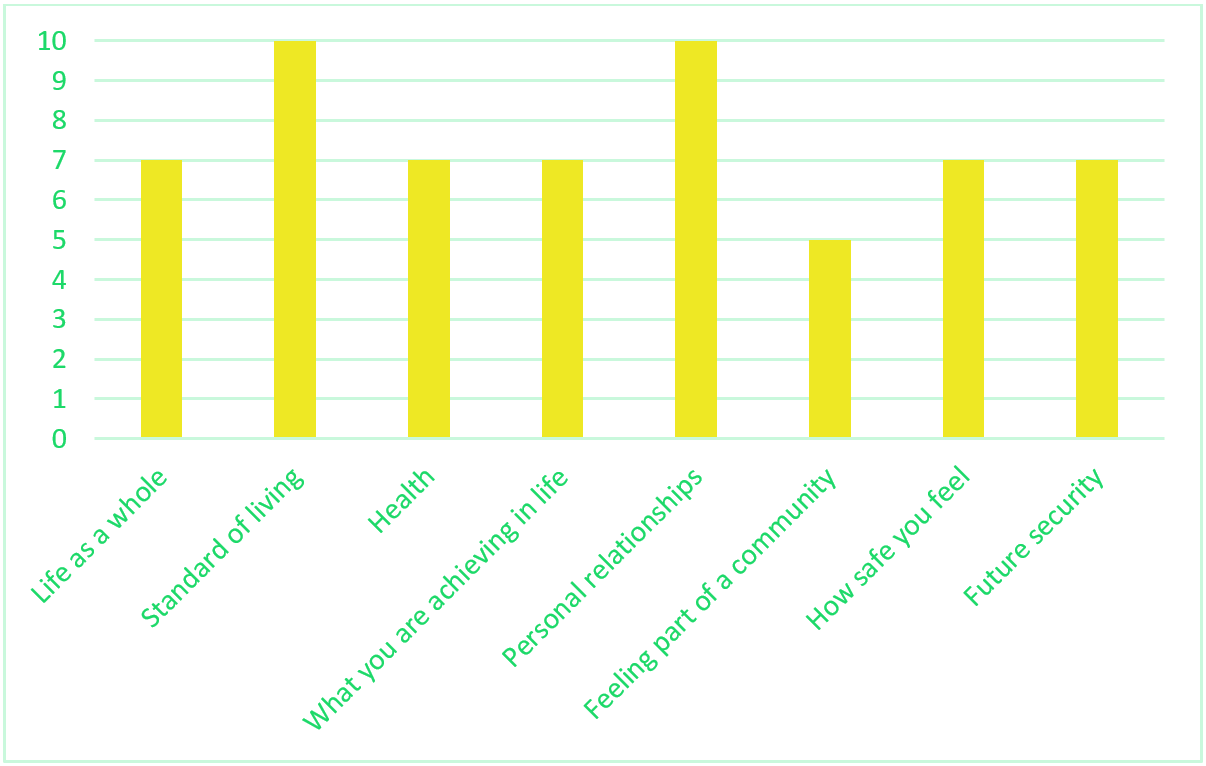
Figure 1. Harriet’s responses to questions asking about personal wellbeing.

Figure 2. Adam’s responses to questions asking about personal wellbeing.
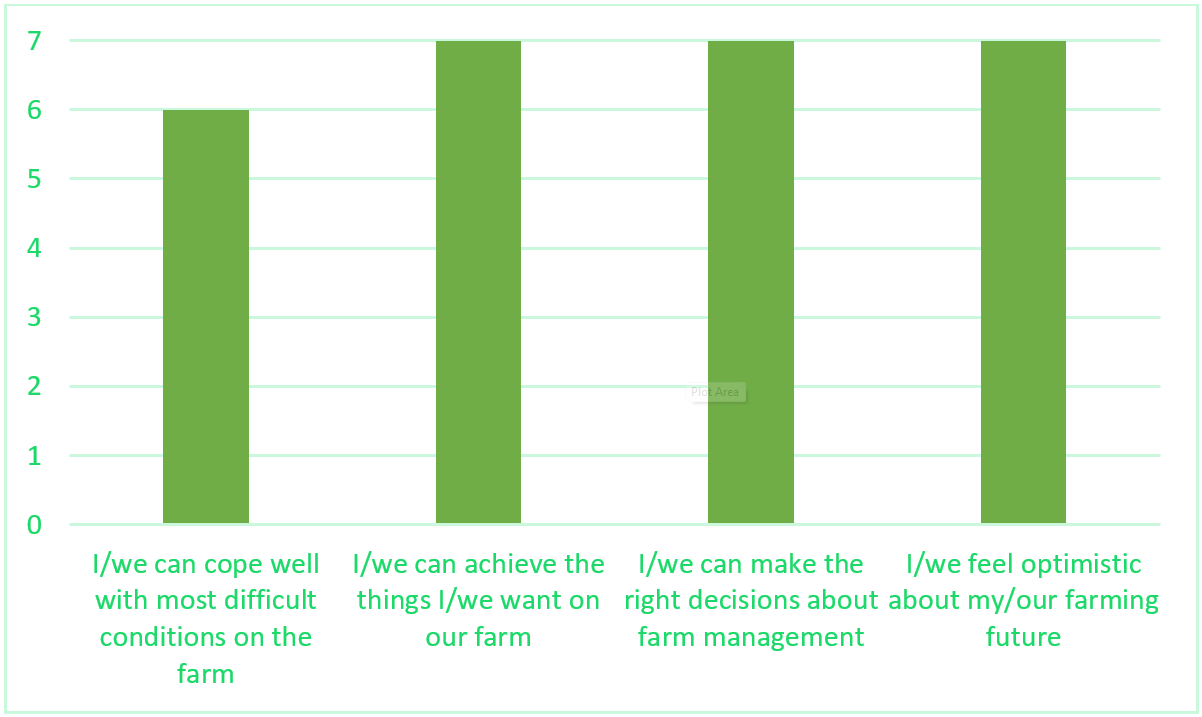
Figure 3. Harriet’s responses to questions asking about her relationship to farming.
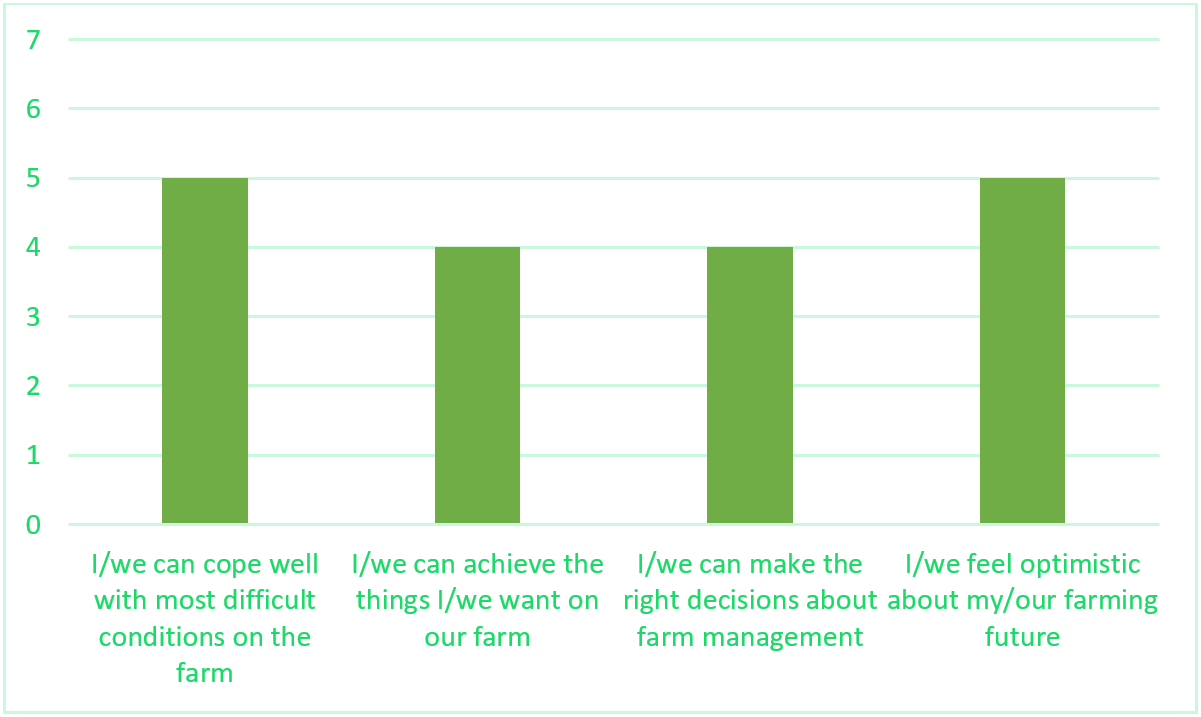
Figure 4. Adam’s responses to questions asking about his relationship to farming.
Full Reports
Download 'Young Farmer' Case StudyPodcast Episodes
Do you have any questions or feedback regarding our case study reports?
We’d love to know more about your profession, location, and reason for accessing the report.
Get in touch, we’re happy to help.
This project is supported by the Australian Government’s Smart Farms Program.




